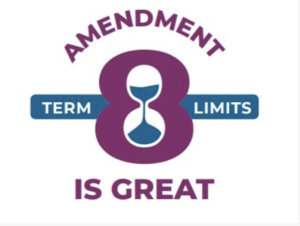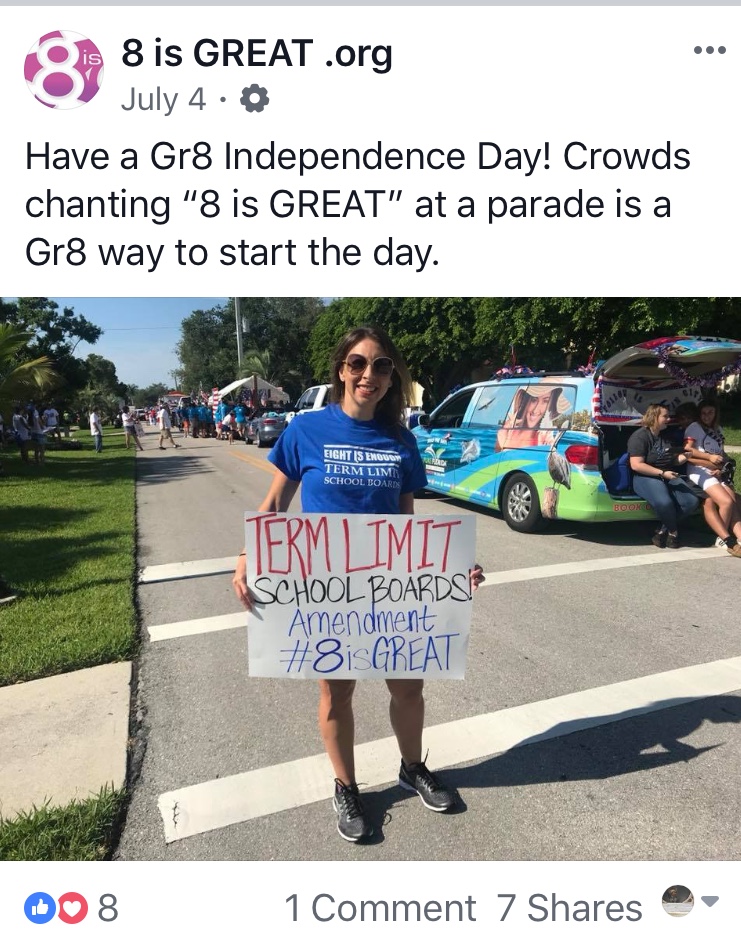Hiding the Ball: the deceptive strategy behind 8isGreat
 The promoters of Florida’s Amendment 8 recently unveiled a new logo which makes clear their intention to hide the true intent of Amendment 8 (allowing alternate systems for establishing of publicly funded schools, funded by local tax dollars but outside the control of locally elected school boards) behind the more popular idea of term limits. How do you do that? Focus on term limits and hope no one notices the attack on elected school boards and local control. Luckily, a Leon County Circuit Judge is on to their deception…
The promoters of Florida’s Amendment 8 recently unveiled a new logo which makes clear their intention to hide the true intent of Amendment 8 (allowing alternate systems for establishing of publicly funded schools, funded by local tax dollars but outside the control of locally elected school boards) behind the more popular idea of term limits. How do you do that? Focus on term limits and hope no one notices the attack on elected school boards and local control. Luckily, a Leon County Circuit Judge is on to their deception…
On August 20th, Leon County Circuit Judge John Cooper ruled that the title and ballot summary for the Florida Constitution Revision Commission’s (FLCRC) education amendment, Amendment 8, “clearly and conclusively fails to adequately inform the voter of the chief purposes and effects of the revision, and is affirmatively misleading” and must be removed from the November ballot.
Our response? “We told you so.” (Read more here).
Amendment 8 (like FLCRC amendments 6-12) is a bundled amendment created by the combination of 3 separate proposals: mandatory 8 year term limits for school board members, promotion of civic literacy and a radical shift in education policy and oversight, stripping local control of public schools by restricting duly elected school boards to only overseeing public schools that were “established by” that school board. As we wrote before, we believe the language in part 3 was carefully crafted to hide the real intent of the proposal:
“The real intent is to allow the state to create a system for authorizing and managing charter schools, or other private options, that would be outside the control of locally elected school boards.
Allowing charter schools (or other non traditional public schools) to be authorized or “established” by a process created by the legislature would completely bypass local control by duly elected school boards. Such language could allow corporate charter systems to create their own authorization pathway, eliminating any control at the community level. An appointed board in Tallahassee may decide where and when new charter schools will be built in your neighborhood. In the meanwhile, local taxpayers will pay for these alternately authorized schools, whether your community wants them there or not.”
Judge Cooper’s ruling specifically addressed the language of the ballot proposal, not the merits of the proposed amendment. We agree with Judge Cooper that the intent of the proposal is not clear from the proposed ballot title and summary.

During the trial, Judge Cooper admitted that, until recently, he was unaware that charter schools were considered public schools and, therefore, would have failed to see the connection between this amendment and corporate charter school authorization and expansion by a state created entity (the clear intent of the “not established by” portion of the proposal).
The Judge’s ruling briefly mentions the bundling of the three proposals but only to suggest that, if unbundled, there would have been ample room to fully explain both the meaning and the effect of the charter school authorization portion of the amendment within the restrictions of a 15 word title and a 75 word summary. It states the FLCRC “chose to bundle the three proposals together to increase, in its view, their chances of passage. But this court can only permit it to do so if it fully and accurately described all three proposals in the ballot title and description. That it failed to do.” For the time being, Amendment 8 is off the ballot. This ruling will surely be appealed.
The proponents’ response to the ruling by the Leon Court Ruling was swift, with sponsor Erika Donalds claiming the bundled policies were “logically grouped together and followed Florida’s constitutional process”(the old “because I said so” argument). Ms. Donalds suggested the lawsuit was less about the language of the ballot proposal and more about the political agenda of the plaintiffs (the League of Women Voters of Florida): “It is disgusting how many misrepresentations the opposition is willing to put forth to block student-centered school choice options.” On social media, 8isgreat Executive Board Member, Shawn Frost, primarily blamed “the (liberal) media” calling them the “media allies” of the teacher’s union.
There was a brief discussion during the 8/17/18 court proceedings regarding the efforts of the Amendment 8 proponents to “hide the ball,” attaching the charter school authorization language to two more popular proposals. This was clearly the strategy “8isgreat” proponents were counting on and still appear to be using. They are hoping voters won’t notice the radical policy they are trying to hide behind school board term limits.
Since 8isGreat.org was created to promote passage of Amendment 8, it has been emphasizing the Term Limits portion of the proposal. Here is 8isGreat’s founder, Erika Donalds, at a 4th of July parade:

Nothing demonstrates the intent to use terms limits to “hide the ball” as much as 8isGreat.org’s new logo, which debuted on August 16th.

Nothing about charter school authorization here… This is clear evidence they intend to keep the REAL intent of Amendment 8 well hidden.
Voters like term limits but they also like local control of their public education dollars AND they don’t like being deceived. We hope the judge’s ruling stands. We will be following closely.


One Comment